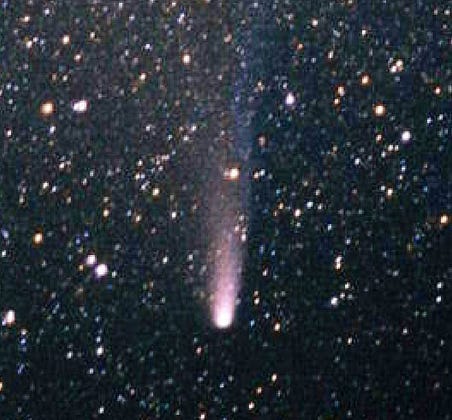
A BRIEF HISTORY OF HALLEY’S COMET
Revised extracts from A Comet Called Halley by Ian Ridpath
(Cambridge University Press, 1985)
Through the Comet’s tail
Through the Comet’s tail
About 3 a.m. GMT on 1910 May 19, Halley’s Comet passed directly between the Sun and Earth. This event was invisible from Greenwich, the Sun being below the horizon at the time, but observers on the other side of the world, in Hawaii, trained their telescopes on the Sun for signs of the Comet’s head silhouetted against its brilliant disk. They saw nothing. Had there been a solid nucleus as little as 100 kilometres across, the astronomers would have seen it as a dark dot crossing the Sun.
Those who believed that the Earth’s passage through the Comet’s tail would mark the end of the world must have feared the worst when violent thunderstorms broke out over England that night. From Leigh-on-Sea in Essex, an imaginative witness described the lightning as being as ‘almost the colour of blood’. At the Paris Observatory, Camille Flammarion reported that four observers ‘had certain olfactory experiences, which are described variously as a smell of burning vegetables, or a marsh, or of acetylene’. Imagination must have got the better of them, for the Earth’s atmosphere would have prevented the rarefied gases of the comet from penetrating any closer than about 100 kilometres from the ground.
From Greenwich on the night of the Earth’s passage through the tail, Andrew C. D. Crommelin noticed strange bands of light in the sky. At first he put them down to clouds but later he wondered whether they were anything to do with the comet. The Engineer-in-Chief of the General Post Office wrote to the Astronomer Royal to inform him that no electrical effects were noted on telephone trunk lines during the Earth’s passage through the tail. With hindsight, it now seems that the Earth did not pass through the centre of the tail, but only through its outskirts.
‘Everything on the Earth will be burnt’
Perhaps the strangest letter about the encounter to be received at Greenwich came from Sze zuk Chang Chin-liang, who wrote from the Imperial Polytechnic College, Shanghai. He thoughtfully enclosed a photograph of himself to accompany his revolutionary theory: ‘It is obvious the comet has no tail at all and the so-called tail must be the Sun rays which, while passing through the body of the comet, look like a tail’. He then confessed his fear: ‘If the body of the comet is transparent and like the Earth has its two poles fairly flat and thus form a convex lens then everything on the Earth will be burnt provided the sunlight passes through the body of the comet and the focus falls on the surface of the Earth’. Since this letter is dated 1912, two years after the event, it seems too late to have worried.
After its passage across the face of the Sun on May 19, Halley’s Comet reappeared in the evening sky, still impressive but fading as it receded. By July it was lost to the naked eye. Telescopes followed the Comet for a year until it was more distant than Jupiter. Then it was gone from sight. Halley’s Comet was not seen again for another 71 years. ☄
Halley and its tail
Halley’s Comet photographed on 1910 April 22 by the English astronomer John Evershed at Kodaikanal Observatory in the mountains of southern India. The image shows an irregularity in the tail, known as a disconnection, caused by a gust in the solar wind.
Extensive photographic and visual observations of the Comet and its tail made at Yerkes Observatory were reported by the great American astronomer Edward E. Barnard in The Astrophysical Journal in 1914.
(Science Museum, London.)
